This page is for personal, non-commercial use. You may order presentation ready copies to distribute to your colleagues, customers, or clients, by visiting https://www.parsintl.com/publication/autoblog/
The Indian FTR 1200 line of motorcycles doesn’t make much sense when you put their specs down on paper. Granted, some people might think motorcycles in general don’t make much sense, but the FTR in particular doesn’t make enough power to be considered a sportbike contender, doesn’t have enough fuel storage or comfortable enough ergonomics to make it a tourer or even a practical day-to-day commuter, and, for obvious reasons, it doesn’t exactly fit in with the chromed-out crowd that burbles up to the local watering hole.
Following a major update for the 2022 model year, the FTR 1200 also loses a good bit of its flat-track heritage in favor of being a better all-around motorcycle. Does it sound incongruous that a niche bike is being altered to make it less niche? Why yes. Yes, it does.
Be that as it may, a month spent with a 2022 FTR 1200 showed it to be a truly excellent motorcycle. It refuses to be pigeonholed into any specific category, and it’s better off because of it. If a buyer is looking for a motorcycle solely to fulfill the desire for two-wheeled fun, the Indian FTR 1200 should be on the short list.
Powered by a 1,203 cubic-centimeter 60-degree V-twin engine that spins out 120 horsepower at 7,750 rpm and a peak of 87 pound-feet of torque. That’s not anywhere near the 200-horsepower that a race-tuned engine of a similar size may produce, but that hardly matters in the real world. The FTR’s engine gets right into the meat of its wide powerband by the time the clutch is fully released without any dead spots and with perfect computer-controlled fueling. Peak torque is reached at a relatively low 6,000 rpm, but it feels like there’s plenty of stonk below that engine speed, and the V-twin doesn’t seem to trail off as it spins toward its redline of around 9,000 rpm.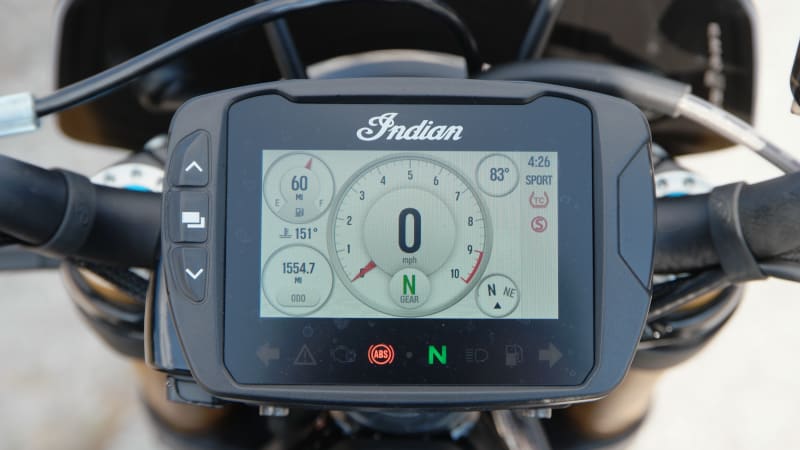
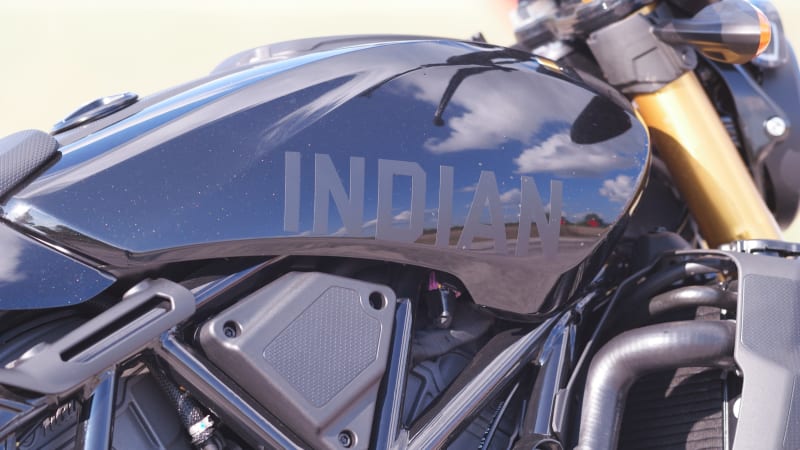
The engine offers Rain, Street and Sport ride modes, and the differences between them are easily felt from the saddle. Sport may be a bit aggressive for street riding, which is fine since Street lived up to its name. Using it, throttle response is immediate, fueling is good, and combined with an easily modulated clutch, the bike’s sporty demeanor shines through without any sort of herky-jerky annoyance.
Cylinder deactivation cuts off the rear cylinder when it’s not needed, which apparently helps the engine keep cool. It was a pretty chilly Midwestern fall and winter when the bike was tested, so heat wasn’t a problem.
Perhaps the most notable change for 2022 is a switch to 17-inch wheels front and rear, replacing the original’s 19-inch front and 18-inch rear wheels. While those older hoops added some flat-track credibility, the switch to a more common size means finding good tires is much easier. The new cast-aluminum wheels wear Metzeler Sportec tires, and there’s a whole bunch of grip available right up to the bike’s maximum lean angle of 43 degrees.
The rejiggering of suspension bits and the wheel and tire package have resulted in slightly more aggressive geometry that makes the new bike feel more street-biased than the first version. It’s still plenty stable, aided by a generous 60-inch wheelbase. It also results in a more approachable seat height of 30.7 inches, which is quite a bit lower than the previous version’s claimed 33.1.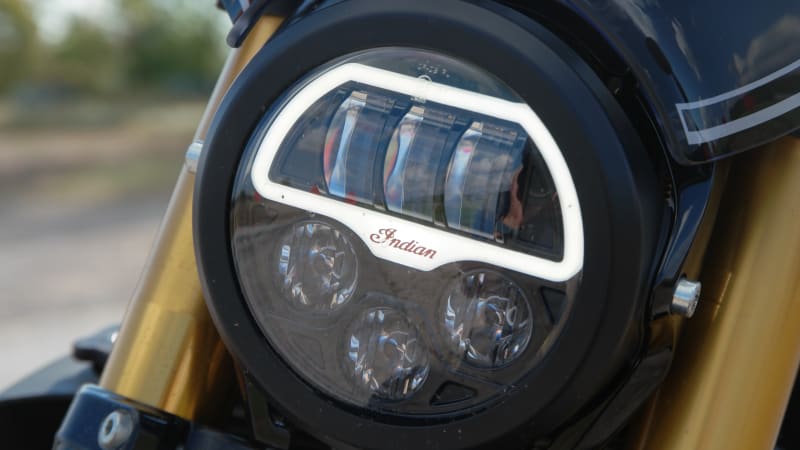
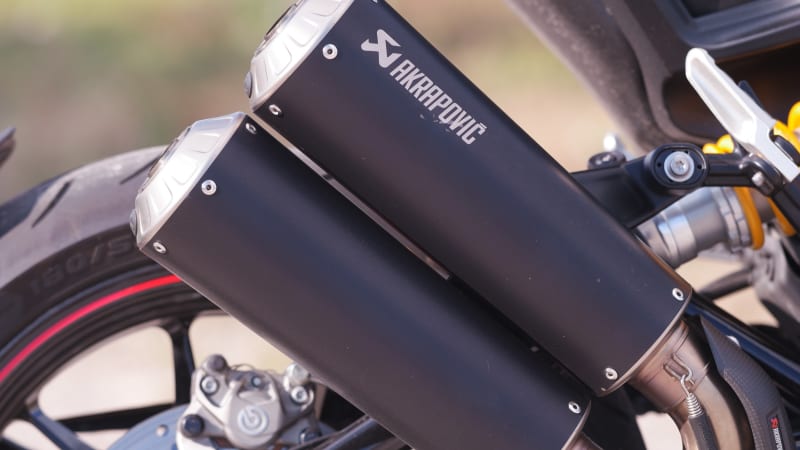
The test bike was a 2022 FTR 1200 S model that starts at $14,999, which is $2,000 more than the base non-S FTR. The bike was fitted with optional accessories and packages from Indian, most notably the Tracker bits that include a longer flat-track-inspired seat and cowl and the up-spec Öhlins 43-millimeter inverted front forks and rear shock with adjustable compression and rebound damping. Those are very nice pieces of kit, but potential buyers should be aware that the front suspension tacks an extra $1,950 and the rear adds another $950. The low-mount slip-on Akrapovič looks and sounds great but adds $1,600 to the sticker.
The base FTR 1200 starts at a buck under $13,000 that uses an analog gauge cluster instead of the test bike’s digital unit and doesn’t come with selectable ride modes, lean-sensitive ABS, stability control, traction control or wheelie control. There’s a FTR R Carbon edition for $17,000 that adds, you guessed it, carbon fiber bodywork along with high-end Öhlins suspension components. It may make more sense to go with the Carbon model instead of replicating the upgrades of this tester. Finally, the Rally model costs $13,999 and is aimed at the rider who may miss the older bike’s unique character, and gets knobby tires and a more relaxed handlebar setup.
Riding the 2022 FTR 1200 S is a blast. It’s a stable ride, but still feels aggressive. Its V-twin won’t set any dyno records, but it responds immediately to throttle inputs and feels like it offers more than enough power for a street bike regardless of where the needle points on the tach. It’s not really a rally-inspired machine anymore — note that the aforementioned Rally model keeps the scrambler-spec wheels and tires, but we haven’t tested it — but its place as a more universal streetbike means it’s appropriate for a wide variety of riding scenarios.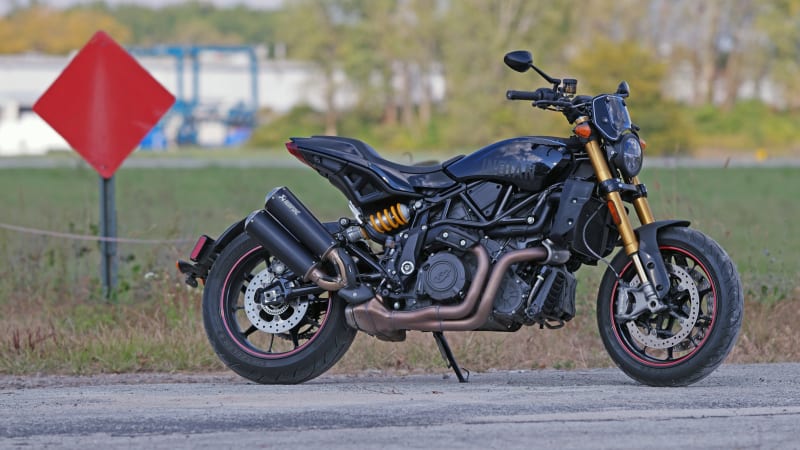
It’s certainly not perfect, though. Its small 3.4-gallon tank is only good for around a hundred miles or so before the rider will be anxiously searching for a gas station. And it’s certainly possible to find a much quicker bike for a similar amount of money, albeit one that’s a lot more high strung, with more track-appropriate ergonomics and less real-world power at lower engine speeds. We’d have more fun on the FTR in everyday riding conditions, for whatever that’s worth.
And that’s the whole point of the Indian FTR 1200, anyway. It’s different, more refined, less niche (though still not mainstream) and likely better than before for the majority of potential buyers. Above all else, it’s just plain fun to ride, and that’s enough to earn a recommendation.
Autoblog accepts vehicle loans from auto manufacturers with a tank of gas and sometimes insurance for the purpose of evaluation and editorial content. Like most of the auto news industry, we also sometimes accept travel, lodging and event access for vehicle drive and news coverage opportunities. Our opinions and criticism remain our own — we do not accept sponsored editorial.
Please sign in to leave a comment.
New Ford Bronco or Vintage? Now you don’t have to choose
Next-gen Ford Mustang hybrid and AWD reportedly dead
2022 Toyota Tundra becomes only pickup to earn IIHS Top Safety Pick+
2023 Jeep Gladiator gets special edition trim and colors
Ford recalls nearly 200,000 Expeditions and Navigators for fire risk
2023 Ford Super Duty reportedly inaugurating a new 6.8-liter V8
News, Reviews, Photos, Videos
delivered straight to your in-box.
Thanks for subscribing.
Check your in-box to get started.
More Info
You must be logged in to perform that action.
Please enter a display name
